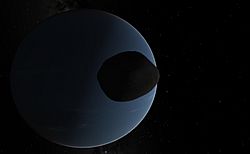Naiad (moon) facts for kids
| Discovered by | Voyager Imaging Team |
|---|---|
| Discovered in | September 1989 |
| Orbital characteristics | |
|
|
|
| Semi-major axis | 48 227 ± 1 km |
| Eccentricity | 0.0004 ± 0.0003 |
| Orbital period | 0.2943958 ± 0.0000002 d |
| Inclination | 4.75 ± 0.03° (to Neptune equator) 4.75° (to local Laplace plane) |
| Is a moon of | Neptune |
| Physical characteristics | |
| Dimensions | 96×60×52 km |
| Mass | ~1.9×1017 kg (based on assumed density) |
| Mean density | ~1.2 g/cm3 (estimate) |
| Rotation period | assumed synchronous |
| Axial tilt | ~zero presumably |
| Albedo (geometric) | 0.07 |
| Surface temp. | ~51 K mean (estimate) |
| Atmosphere | none |
Naiad or Neptune III is the closest moon to Neptune named after the Naiads of Greek legend. It was found sometime before mid-September, 1989 from the images taken by the Voyager 2 probe. The last moon to be discovered during the flyby, it was designated S/1989 N 6. Naiad is not a sphere and probably has not been changed by any internal geological processes after its formation. It orbits about 23,500 km above Neptune's cloud tops.
Since the Voyager 2 flyby, the Neptune system has been studied a lot from ground-based observatories and the Hubble Space Telescope as well. In 2002-03, Keck telescope looked at the system using adaptive optics and detected easily the biggest four closer satellites. Thalassa was found with some image processing, but Naiad was not located.
Images for kids
See also
 In Spanish: Náyade (satélite) para niños
In Spanish: Náyade (satélite) para niños



